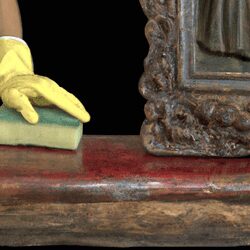Restoration and Refinishing Techniques for Antique Wooden Furniture
Antique wooden furniture can add charm and character to any home, but it also requires special care and attention to preserve its beauty and value. Over time, wooden furniture can suffer from wear and tear, damage, dirt, and fading, which can diminish its appearance and functionality. Fortunately, there are ways to restore and refinish antique wooden furniture to bring back its original luster and extend its lifespan.
In this article, we will explore some of the restoration and refinishing techniques that you can use to revive your antique wooden furniture and make it look like new again.
Cleaning Antique Wooden Furniture
The first step in any restoration and refinishing project is to clean the furniture thoroughly to remove any dirt, dust, grime, wax, or polish that may have accumulated over the years. Cleaning the furniture will also help you assess the condition of the finish and the wood, and decide what kind of repairs or refinishing are needed.
To clean antique wooden furniture, you will need to follow these steps:

- Mix some liquid dish soap with water in a bucket, and dip a sponge or a rag into the solution. Wring it out, and gently scrub the surface of the furniture. Use a paintbrush to clean the details and crevices. Rinse the surface with a clean, damp sponge or rag, and dry it with a towel. Repeat this process until the furniture is clean and free of any soap residue.
- If the furniture is still dirty or has some stubborn stains, you can use mineral spirits or vinegar to remove them. Mineral spirits can also help you determine how the furniture will look with a fresh coat of finish, as it temporarily saturates the finish and reveals its true color and shine. To use mineral spirits, dampen a rag with the solvent, and wipe the surface of the furniture. Let it dry, and observe the results. If the furniture looks good, you may not need to strip or sand the old finish, and you can proceed to apply a new coat of finish. If the furniture looks bad, you may need to remove the old finish and refinish the furniture from scratch. To use vinegar, mix one part white vinegar with one part water, and apply it to the stained areas with a rag or a sponge. Let it sit for a few minutes, and then wipe it off with a clean, damp rag. Vinegar can help remove water stains, ink stains, and mildew from the furniture.
Repairing Antique Wooden Furniture
After cleaning the furniture, you may notice some cracks, chips, scratches, dents, or loose joints that need to be repaired. Repairing the furniture will not only improve its appearance, but also its structural integrity and stability.
To repair antique wooden furniture, you will need to follow these steps:

- To repair cracks and chips, you will need some wood filler, a putty knife, and some sandpaper. Wood filler is a paste-like substance that can fill in the gaps and holes in the wood, and harden to match the texture and color of the wood. To use wood filler, apply a small amount of it to the crack or chip with a putty knife, and smooth it out. Let it dry, and then sand it lightly with sandpaper to blend it with the surrounding wood. You can also stain or paint the wood filler to match the finish of the furniture.
- To repair scratches and dents, you will need some wood stain, a cotton swab, and a cloth. Wood stain is a liquid that can penetrate the wood and change its color, making the scratches and dents less noticeable. To use wood stain, dip a cotton swab into the stain, and apply it to the scratch or dent. Wipe off the excess stain with a cloth, and let it dry. Repeat this process until the scratch or dent is camouflaged.
- To repair loose joints, you will need some wood glue, a clamp, and a hammer. Wood glue is a strong adhesive that can bond the wood pieces together and reinforce the joints. To use wood glue, apply a thin layer of it to the joint, and press the wood pieces together. Clamp the joint, and let the glue dry. You can also use a hammer to tap the joint gently to make sure it is tight and secure.
Refinishing Antique Wooden Furniture
The final step in restoring and refinishing antique wooden furniture is to apply a new coat of finish to the furniture. The finish is the protective layer that covers the wood and gives it its color and shine. The finish can also enhance the grain and the beauty of the wood, and protect it from moisture, stains, and scratches.
There are different types of finishes that you can use to refinish antique wooden furniture, such as oil, wax, shellac, lacquer, varnish, or polyurethane. Each type of finish has its own advantages and disadvantages, depending on the desired look and durability of the furniture. You can also choose between a matte, satin, or glossy finish, depending on your personal preference.
Before you apply a new coat of finish, you may need to remove the old finish first, especially if it is damaged, discolored, or incompatible with the new finish. To remove the old finish, you can use a chemical stripper or sandpaper. A chemical stripper is a liquid or gel that can dissolve the old finish and make it easy to scrape off. A sandpaper is a paper with abrasive particles that can grind off the old finish and smooth the wood.
To refinish antique wooden furniture, you will need to follow these steps:
- To remove the old finish with a chemical stripper, you will need to apply it to the surface of the furniture with a brush, and let it sit for the recommended time. Then, use a scraper or a steel wool to remove the old finish. Wipe the surface with a rag dampened with mineral spirits to remove any residue.
- To remove the old finish with sandpaper, you will need to start with a coarse-grit sandpaper, and sand the surface of the furniture in the direction of the grain. Then, switch to a finer-grit sandpaper, and sand the surface again. Repeat this process until the old finish is removed and the wood is smooth.
- To apply a new coat of finish, you will need a brush, a rag, or a spray gun, depending on the type of finish you are using. You will also need some gloves, a mask, and a well-ventilated area to protect yourself from the fumes and the dust. Follow the instructions on the label of the finish, and apply it to the surface of the furniture in thin, even coats. Let each coat dry, and lightly sand it with a fine-grit sandpaper before applying the next coat. Repeat this process until you achieve the desired color and shine. You can also apply a clear coat of finish, such as polyurethane, to seal and protect the furniture.
Conclusion
Restoring and refinishing antique wooden furniture can be a rewarding and satisfying project that can transform your old and worn furniture into a new and beautiful piece. By following the steps of cleaning, repairing, and refinishing, you can preserve the history and the value of your antique wooden furniture, and enjoy it for many years to come.



